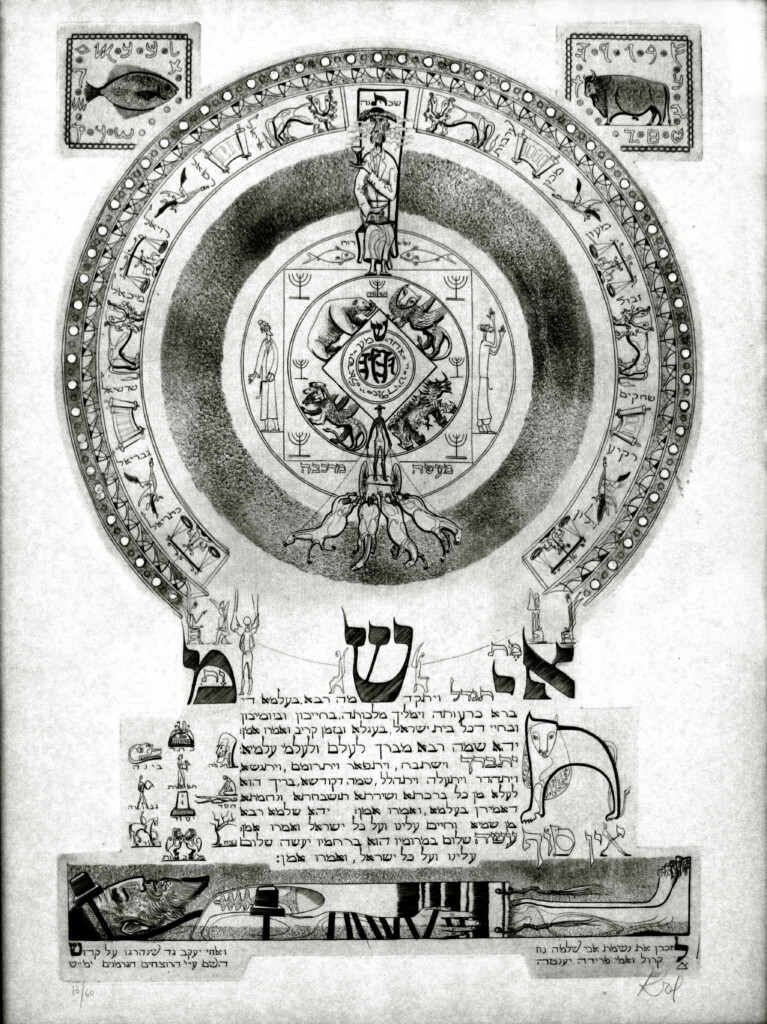TIOH Art Tour: Kabbalistic Dedication – Series
- By Abraham Krol
- Numbered engravings made using copper lithograph plates and single burin.
- Lithograph a
- Depicting signs of zodiac, Kabbalistic and angelology references. Corpse dressed in Tallit and Phylacteris. Hebrew inscription citing kaddish prayer dedicated to artist’s parents and brother killed by Nazis.
- Numbered 13/60
- Lithograph b
- Depicting alphabet encircled by signs of the zodiac leviathan (midrash, Sea Monsters), and corpse. Hebrew inscription prayer for deceased, dedicated to artist’s parents.
- Numbered 2/60


Parisian Jewish artist Abram Krol is represented in major museum collections and exhibitions of great painters of the world. The dramatic lithographs (handmade prints made in limited quantities – in this case, only 60 were made) seen here are master examples of the imaginative use of Hebrew calligraphy, and the Jewish iconography of death and rich with symbolism.
The pieces serve as a visual kaddish by the Polish-born artist, mourning his parents and brother who were killed by the Nazis. While the traditional kaddish recited by grieving family members is an ancient prayer in Aramaic, glorifying god and accepting his sovereignty, Krol’s pieces reference mystical symbols and metaphors from kabbalistic imagery and angelology.
At the center of the top piece (lithograph a) you can see a medallion with the most sacred of Jewish prayers, the Sh’ma – Sh’ma Yisrael, Adonai Eloheinu, Adonai Echad! Hear, O Israel, Adonai is our God, Adonai is One! Surrounding the medallion is an illustration of the vision of the prophet Ezekiel found in Book of Ezekiel, Chapter 1. The vision of Ezekiel is awe inspiring. It reads, “…and I looked, and, behold, a stormy wind came out of the north, a great cloud, with a fire flashing up, so that a brightness was round about it; and out of the midst thereof as the color of electrum, out of the midst of the fire. And out of the midst thereof came the likeness of four living creatures. And this was their appearance: they had the likeness of a man. And every one had four faces, and every one of them had four wings. And their feet were straight feet; and the sole of their feet was like the sole of a calf’s foot; and they sparkled like the color of burnished brass….” The vision ends with a revelation. Ezekiel concludes the vision, “As the appearance of the bow that is in the cloud in the day of rain, so was the appearance of the brightness round about. This was the appearance of the likeness of the glory of the Lord. And when I saw it, I fell upon my face, and I heard a voice of one that spoke….”
This vision is part of the main corpus of mystical and Kabbalistic literature. It is very rare for these visions for be drawn; studying these passages are reserved for the most devout and dedicated students, usually those over the age of 40 and versed in Torah and Talmud.
While the pieces are full of clues and metaphors, the bottom of the depicts the artist figuratively burying his parents, Shlomo Noah and Frida Yente, and his brother, Yaakov Gad. The representation is of a pious Jew buried in his tefillin (phylacteries) and his tallit (prayer shawl). At his feet are the words Ein Sof, meaning never ending eternity, and at his forehead the artist puts the elements of the tree of life known as the sefirot in mystical Jewish traditions. Each branch has a different meaning illustrating our attempts to understand the divine in our world. At the top is the keter, the crown representing the Divine, also known as the Infinite Light of the Creator. Chochma and Bina, wisdom and understanding are drawn as heads, evoking the first unbounded flash of an idea, before it takes on the limitations of reality. Once it crashes into reality, the infinite flash is brought into the vessel of understanding. There, it gains breadth and depth. At the bottom of the lithograph the symbol of Malchut, meaning Kingship, represents the pregnant female vessel for nurturing, rejuvenation, creation, and humanity. It is sometimes characterized as a revelation.
The bottom piece (lithograph b) is also a kaddish, but in this lithograph the artist employs the Leviathan, Liv Yatan, as a central figure. This massive mythical creature which appears in the Tanakh many times represents the beginning of time and the ocean that appears at the beginning of our history and in many places in eschatology (both Jewish and Christian) as a beast to be slain. Many magical properties have been attributed to its flesh, its skin, and its eyes representing an end of the days when all will be revealed, and the righteous will enjoy everlasting happiness.
Right below the Leviathan, the image of Krol’s buried father is powerful as the anchor and root of the piece, but this time the prayer written below him is el maleh rachamim, a funeral prayer used by mostly Ashkenazi Jews for the ascension of the souls of the dead. A chazzan (leader) recites it during a funeral, going up to the grave of the departed on remembrance days, and on other occasions on which the memory of the dead is recalled. Perhaps the artist puts it at the bottom of the piece under the mythical creature to remind us that many victims of the Nazis were not buried, and their families and descendants do not know what has happened to them.
At the top of the piece, we see other medallions. The outer circle represents the 12 tribes of Israel and their coat of arms. The middle circle depicts the Hebrew alphabet – the letters that compose all the prayers, literature, poetry, and lamentations of Jewish life. The center of the medallion bears the tetragrammaton – the four letters of God’s name, yud hey vav hey – the unpronounceable and holy name of God.
Home